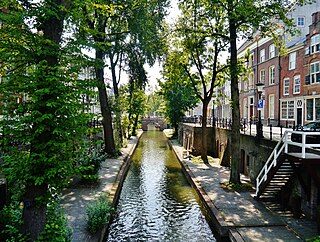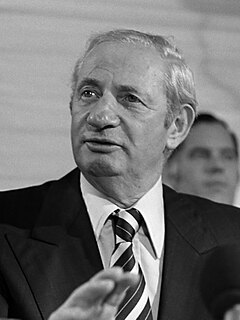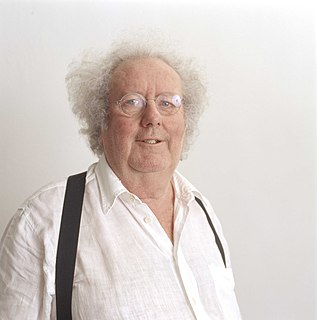
The Rijksmuseum is a Dutch national museum dedicated to arts and history in Amsterdam. The museum is located at the Museum Square in the borough Amsterdam South, close to the Van Gogh Museum, the Stedelijk Museum Amsterdam, and the Concertgebouw.

Utrecht is the fourth-largest city and a municipality of the Netherlands, capital and most populous city of the province of Utrecht. It is located in the eastern corner of the Randstad conurbation, in the very centre of mainland Netherlands; it had a population of 357,179 as of 2019.

Misha Mengelberg was a Dutch jazz pianist and composer. A prominent figure in post-WWII European Jazz, Mengelberg is known for his forays into free improvisation, for bringing humor into his music, and as a leading interpreter of songs by fellow pianists Thelonious Monk and Herbie Nichols.

The Stedelijk Museum Amsterdam, colloquially known as the Stedelijk, is a museum for modern art, contemporary art, and design located in Amsterdam, Netherlands.

The Amsterdam School is a style of architecture that arose from 1910 through about 1930 in the Netherlands. The Amsterdam School movement is part of international Expressionist architecture, sometimes linked to German Brick Expressionism.

Petrus Josephus Hubertus "Pierre" Cuypers was a Dutch architect. His name is most frequently associated with the Amsterdam Central Station (1881–1889) and the Rijksmuseum (1876–1885), both in Amsterdam. More representative for his oeuvre, however, are numerous churches, of which he designed more than 100. Moreover, he restored many monuments.

Atje Keulen-Deelstra was a Dutch speed skater, who was a four-time World Allround Champion between the age of 32 and 36.

Carolina ("Carry") Cornelia Catharina Geijssen is a former speed skater from the Netherlands.

FC Blauw-Wit Amsterdam was a Dutch football club from Amsterdam. The name referred to the colours of their uniform, blue and white.

Geldolph Adriaan "Dolf" Kessler was a Dutch footballer and industrialist. Kessler – along with brother Boeli and cousins Tonny and Dé – played club football for amateur side HVV Den Haag. Kessler also won three caps for the Dutch national side between 1905 and 1906.

Zwarte Piet is the companion of Saint Nicholas in the folklore of the Low Countries. The earliest known illustration of the character comes from an 1850 book by Amsterdam schoolteacher Jan Schenkman in which he was depicted as a black Moor from Spain. According to folklore, the skin of Zwarte Piet is colored by soot from going down chimneys to bringing presents into people's houses. Those portraying Zwarte Piet usually put on blackface and colourful Renaissance attire in addition to curly wigs and bright red lipstick. In recent years, the character has become the subject of controversy.
Rykel de Bruyne is a Dutch malacologist.

The Eastern Docklands is a neighborhood of Amsterdam, Netherlands, located between the IJ and the Amsterdam–Rhine Canal in the borough of Amsterdam-Oost. The harbor area was constructed in the late nineteenth century to allow for increasing trade with the Dutch East Indies; a new location was necessitated by the construction of the Amsterdam Centraal railway station, which replaced the old quays. East of the new station was a marshy area called De Rietlanden, with the Zeeburgerdijk, running via the Zeeburch, a fort, to the Zuiderzee.

The Zomerdijkstraat is a small street in the Amsterdam neighborhood Rivierenbuurt, consisting of apartment buildings and a hallmark building, the studio complex at the Zomerdijkstraat. A classified monument, the building was designed by the functionalist architects Piet Zanstra, J.H.L. Giesen en K.L. Sijmons.

Michiel Riedijk is a Dutch architect and professor at the Technical University Delft. He is co-founder of the architecture office Neutelings Riedijk Architects in Rotterdam, Netherlands.
Pieter Adriaan Jacobus "Piet" Moojen was a Netherlands-Indies architect, painter and writer. He studied architecture and painting in Antwerp. He lived and worked in the Dutch East Indies from 1903 to 1929. He was one of the first architects to implement Modernism in the Dutch East Indies. Moojen became widely known for his work on the Dutch entry at the Paris Colonial Exposition in 1931. He was active as an architect between 1909 and 1931.

The Maupoleum (1971–1994) was a building on Amsterdam's Jodenbreestraat. Built in 1971, it acquired a reputation for being unattractive before being demolished in 1994.

Maurits "Maup" Caransa was a Dutch businessman who became one of the most important real-estate developers in post-World War II Amsterdam. Caransa was the first well-known Dutch person to be kidnapped for ransom. Caransa owned and built many notable buildings in Amsterdam including the Maupoleum and the Caransa Hotel. He influenced the Amsterdam football club AFC Ajax, through his friendship with its chairman, and by supporting the team and players financially.
Jan Frederik ("Frits") Staal, was a Dutch architect, and a major figure in the development of modern architecture in the Netherlands in the first half of the twentieth century. He was the father of the architects Arthur and Georges Staal and the linguist and South Asia scholar Jan Frederik Staal.

Moshé Zwarts was a Dutch architect, founder of the architectural office ZJA and a former senior professor of Architectural Technology at the Technical University of Delft and the Technical University of Eindhoven. His portfolio encompasses many infrastructural projects including football stadiums.






















